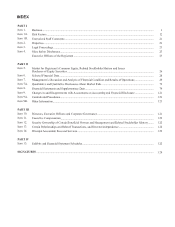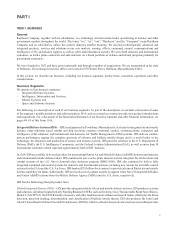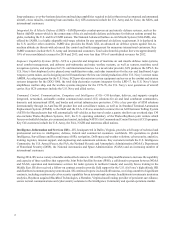Raytheon 2014 Annual Report Download - page 19
Download and view the complete annual report
Please find page 19 of the 2014 Raytheon annual report below. You can navigate through the pages in the report by either clicking on the pages listed below, or by using the keyword search tool below to find specific information within the annual report.10
in our products. We timely filed our first DRC minerals report on Form SD in 2014 stating that we were not able to determine
the country of origin of conflict minerals contained in our manufactured products.
In recent years, our revenues in the second half of the year have generally exceeded revenues in the first half. The timing of
new program awards, the availability of U.S. Government funding, the timing of international contract awards and approvals,
and product delivery schedules are among the factors affecting the periods in which revenues are recorded. We expect this
trend to continue in 2015.
Competition
We directly participate in most major areas of development in the defense and government electronics, space, information
technology and technical services and support markets. Technical superiority, reputation, price, past performance, delivery
schedules, financing and reliability are among the principal competitive factors considered by customers in these markets.
We compete worldwide with a number of U.S. and international companies in these markets, some of which may have more
extensive or more specialized engineering, manufacturing and marketing capabilities than we do in some areas. We frequently
partner on various programs with our major suppliers, some of whom are, from time to time, competitors on other programs.
In addition, U.S. defense spending levels in the near future are increasingly difficult to predict. Changes in U.S. defense
spending may potentially limit certain future market opportunities. See Item 1A “Risk Factors” and “Overview” within Item 7
of this Form 10-K for a more detailed discussion of these and other related risks.
Patents and Licenses
We own an intellectual property portfolio that includes many U.S. and foreign patents, as well as unpatented trade secrets and
know-how, data, software, trademarks and copyrights, all of which contribute to the preservation of our competitive position
in the market. In certain instances, we have augmented our technology base by licensing the proprietary intellectual property
of others. We also license our intellectual property to others, including our customers, in certain instances. The U.S. Government
has licenses in certain of our intellectual property, including certain patents, developed in the performance of U.S. Government
contracts, and has the right to use and authorize others to use such intellectual property, including the inventions covered by
such patents for U.S. Government purposes. While our intellectual property rights in the aggregate are important to our
operations, we do not believe that any particular trade secret, patent, trademark, copyright, license or other intellectual property
right is of such importance that its loss or termination would have a material adverse effect on our business.
Employment
As of December 31, 2014, we had approximately 61,000 employees. Approximately 8% of our employees are unionized. We
consider our union-management relationships to be generally satisfactory.
Environmental Regulation
Our operations are subject to and affected by a variety of international, federal, state and local environmental protection laws
and regulations. We have provided for the estimated cost to complete remediation—or, in the case of multi-party sites, our
reasonably expected share thereof—where we have determined that it is probable that we will incur such costs in the future
in connection with (i) facilities that are now, or were previously, owned or operated by us, (ii) sites where we have been named
a Potentially Responsible Party (PRP) by the Environmental Protection Agency (EPA) or similarly designated by other
environmental agencies, or (iii) sites where we have been named in a cost recovery or contribution claim by a non-governmental
third-party. It is difficult to estimate the timing and ultimate amount of environmental cleanup costs to be incurred in the future
due to the uncertainties regarding the extent of the required cleanup, the discovery and application of innovative remediation
technologies, and the status and interpretation of laws and regulations.
In order to assess the potential impact on our consolidated financial statements, we estimate the possible remediation costs
that we could reasonably incur. Such estimates take into consideration the professional judgment of our environmental
professionals and, in most cases, consultations with outside environmental specialists.
If we are ultimately found to have liability at a multi-party site where we have been designated a PRP or have been named in
a cost recovery or contribution claim from a non-governmental third-party, we expect that the actual costs of remediation will
be shared with other PRPs. Generally in the U.S. and certain other countries, PRPs that are ultimately determined to be
responsible parties are strictly liable for site clean-up and usually agree among themselves to share, on an allocated basis, the
costs and expenses for investigation and remediation of hazardous materials. Under existing U.S. environmental laws,
responsible parties are usually jointly and severally liable and, therefore, potentially liable for the full cost of funding such
























